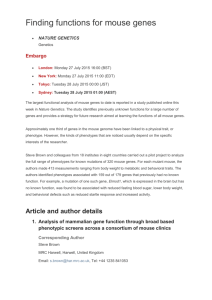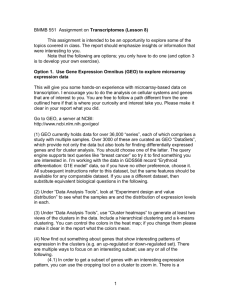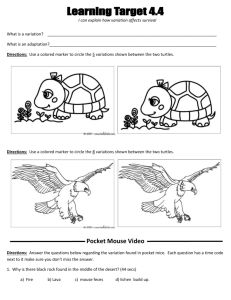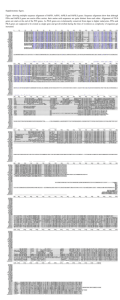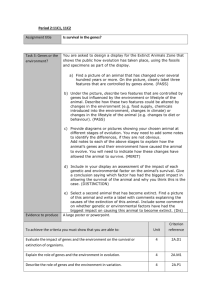Supplemental results
advertisement
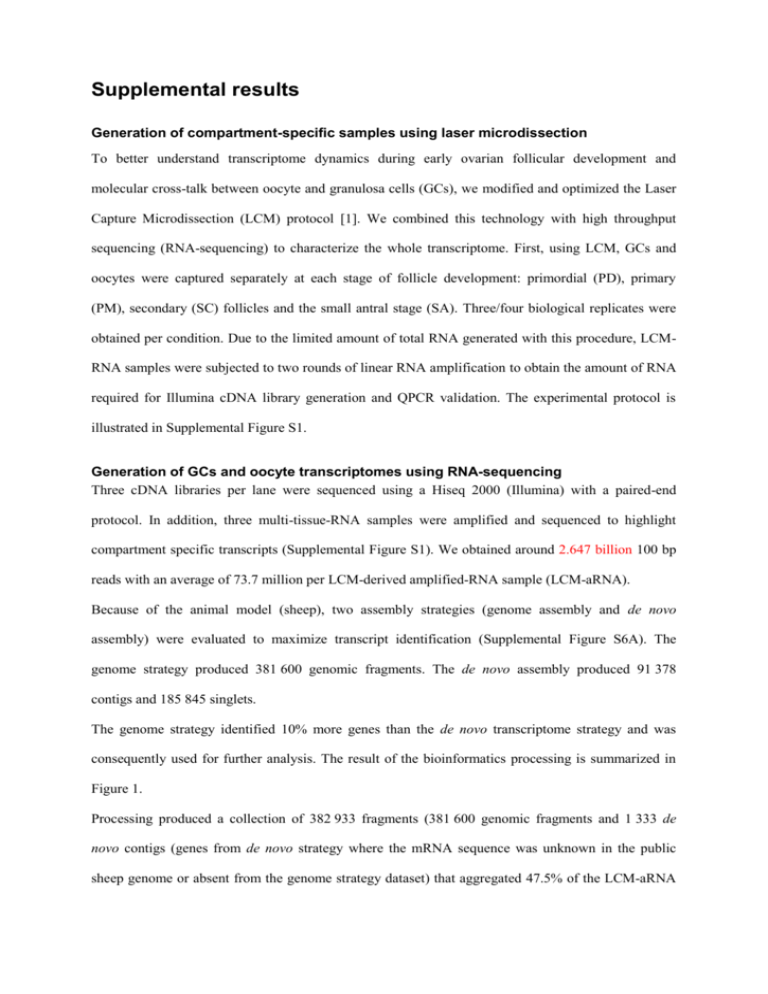
Supplemental results Generation of compartment-specific samples using laser microdissection To better understand transcriptome dynamics during early ovarian follicular development and molecular cross-talk between oocyte and granulosa cells (GCs), we modified and optimized the Laser Capture Microdissection (LCM) protocol [1]. We combined this technology with high throughput sequencing (RNA-sequencing) to characterize the whole transcriptome. First, using LCM, GCs and oocytes were captured separately at each stage of follicle development: primordial (PD), primary (PM), secondary (SC) follicles and the small antral stage (SA). Three/four biological replicates were obtained per condition. Due to the limited amount of total RNA generated with this procedure, LCMRNA samples were subjected to two rounds of linear RNA amplification to obtain the amount of RNA required for Illumina cDNA library generation and QPCR validation. The experimental protocol is illustrated in Supplemental Figure S1. Generation of GCs and oocyte transcriptomes using RNA-sequencing Three cDNA libraries per lane were sequenced using a Hiseq 2000 (Illumina) with a paired-end protocol. In addition, three multi-tissue-RNA samples were amplified and sequenced to highlight compartment specific transcripts (Supplemental Figure S1). We obtained around 2.647 billion 100 bp reads with an average of 73.7 million per LCM-derived amplified-RNA sample (LCM-aRNA). Because of the animal model (sheep), two assembly strategies (genome assembly and de novo assembly) were evaluated to maximize transcript identification (Supplemental Figure S6A). The genome strategy produced 381 600 genomic fragments. The de novo assembly produced 91 378 contigs and 185 845 singlets. The genome strategy identified 10% more genes than the de novo transcriptome strategy and was consequently used for further analysis. The result of the bioinformatics processing is summarized in Figure 1. Processing produced a collection of 382 933 fragments (381 600 genomic fragments and 1 333 de novo contigs (genes from de novo strategy where the mRNA sequence was unknown in the public sheep genome or absent from the genome strategy dataset) that aggregated 47.5% of the LCM-aRNA reads. Last, the annotation strategy based on the bovine genomic sequence homology and annotation search was extended to downstream regions of the genes (500 bp, 1 kb and 3 kb, Supplemental Figure S6B) improved the read annotation by 8% and assigned 73% of the mapped reads. This strategy revealed a longer 3’ untranslated region than available in the EMBL sequence database for at least 3 186 genes (from the final data set). A total of 221 716 genomic fragments remain unannotated. The result of the assembly and annotation processes showed that the read distributed along the genes clustered mostly towards the 3’ UTR ends and is illustrated with ZP4 gene in Supplemental Figure S7. This 3’ bias was expected and reflects the RNA amplification that follows LCM [2, 3]. This bias increased the heterogeneity of expression along the genes. A total of 86.8% of the annotated reads were located in stop codon or 3’UTR regions, whereas only 5.5% were located in exons, 1.2% in start codon or 5’UTR regions, and 6.5% in introns (Figure 1). As reported by Ameur and Teichert [3, 4], the presence of intronic RNA might represent incompletely processed transcripts or alternative splicing events. In addition, we observed that a gene was represented by a median number of eight fragments (Supplemental Figures S7-8). Consequently, to quantify gene expression, the final dataset conserved a single fragment per gene that located closest to the 3’UTR region with the highest number of reads and aggregated 89.4% of the annotated LCM-aRNA reads (86.8% were located in 3’ UTR regions and 2.6% were located in exons). For each sample, supplemental Table 1 (in Supplemental Results and Discussion) summarizes the number of reads, fragments and genes identified during the bioinformatic workflow. The level of expression throughout the experiment (amplification, RNA-seq) was examined using a set of 4 B. subtilis transcripts (Supplemental Figure S6C). Supplemental Figure S9 shows that the expression profile of these transcripts was similar to the theoretical expression profile (derived from the Affymetrix amount) for all the samples (correlation >0.8). As previously described [5, 6], the two rounds of amplification and RNA-seq processes resulted in no significant distortion of the transcript population. Finally, to evaluate the reproducibility of the RNA-seq measure, PDG4 was sequenced twice (PDG4 and PDG4B). The two technical replicate files showed a good correlation (r=0.99) and indicated that the transcript abundance measurement was reproducible. Supplemental Discussion Comparative studies of gene expression This RNA-seq study documented the global expression of 15 349 genes in ovarian follicles during early follicular development in sheep. Using this technology, we estimated a larger number of genes expressed in oocytes (14 172 genes expressed in ¾ of replicates) than other microarray studies performed on mouse and human during early follicular development. Pan et al. detected around 9 330 unigenes in PD, PM, SC and SA mouse oocytes [7] and Markholt et al. found a total of 6 301 unique genes expressed in PD/PM human oocytes [8]. Compared to our preliminary study [1], we found that RNA-seq technology was better and more sensitive for the study of basal folliculogenesis in sheep. In practice, microarray supports are often poorly annotated, poorly oriented and incomplete for non-model species and do not enable the study of complete processes like folliculogenesis [9]. On one hand, the bovine Affymetrix chip included 24 024 probes of which only 64% are annotated, corresponding to 12 404 unique genes. In addition, a great number of known ovarian genes are not present on bovine Affymetrix chip (37% of the oocyte genes and 47% of the GC genes already identified in four previous studies [1]). On the other hand, our RNAseq experiment identified the expression of 2.5 times more genes (14 561 genes in PD, PM and SC samples compared to 5 909 genes in the Affymetrix experiment). This significant difference between the two technologies can be attributed to more exhaustive detection combined with better detection by RNA-seq of weakly expressed genes. Indeed, we identified a large number of genes with a lower expression (the median expression was 140 RPM in a scale that ranged from 0.2 to 1 000 RPM). Finally, RNA-seq detected an additional 20% of known mouse genes compared to the bovine Affymetrix support. An increase of 22% in the number of genes detected by RNA-seq versus Affymetrix chip was also mentioned with respect to human colon cancer by Xu et al. [10]. Sixty-six percent of the specifically expressed genes reported in our preliminary sheep study using the bovine Affymetrix chip [1] were detected by RNA-seq but only 23% of them were confirmed as differentially expressed by DESeq (Supplemental Table 2: in supplemental Results and Discussion). Indeed, RNAseq statistical analysis described and accounted for the marked variation in biological replicates (3-4 biological replicates) and produced a more robust statistic (pval<0.5%) than previous microarray data (without replicate). Finally, our RNA-seq data recovered between 44% and 76% of the genes previously described in studies of mouse oocytes/ Paillisson et al. [11], Pan et al [7] and Gallardo et al. [12], Arraztoa et al. [13] (Supplemental Table 2: from supplemental Results and Discussion). Supplemental Tables Table 1 - Summary of bioinformatics data processing Summary of the results of data set processing in terms of the number of reads (columns 2-5) and genomic fragments (columns 6-8) for: 1- Mapping against the sheep genome sequence and the bovine genome sequence (for annotated de novo contigs without sheep sequences)(columns 3 and 6), 2- The annotation using the bovine genome reference (columns 4 and 7) 3- The filtration process (columns 5 and 8)(see methods) Each independent biological replicate is denoted 1, 2, 3, or 4. * corresponds to the number of expressed genes (see Methods: a single genomic fragment/ annotation) Sample PDO1 PDO2 PDO3 PMO1 PMO2 PMO3 PMO4 SCO1 SCO2 SCO3 SCO4 SAO1 SAO2 Number of reads 59107022 78712828 52507048 66533942 54853348 74817756 67907894 28458350 76037636 134799296 82581444 104296372 76471372 Number of mapped reads 29491038 36565964 25887008 31717742 28382894 36443126 34265311 13823263 34143054 67472656 40182001 47013302 39081300 Number of annotated reads 21909066 26131630 18696000 23153342 20326266 25827283 24841668 9943772 23995757 48449300 28964036 33675297 29148055 Number of post-trimmed reads 19631107 22729122 16543170 20776619 17842928 22727998 21911423 8772385 20995166 43076217 25669933 29846215 25856211 Number of fragments 136856 106849 83224 100956 100424 82386 167705 73667 56313 91600 103392 63058 71998 Number of annotated fragments 66644 52346 41212 50312 48642 39525 77813 37139 29439 45448 50055 33146 38993 Number of post-trimmed annotated fragments* 14239 13455 12545 13417 13237 12267 14504 12227 11590 13181 13261 12037 12038 SAO3 SAO4 PDG1 PDG2 PDG3 PDG4 PDG4bis PMG1 PMG2 PMG3 PMG4 SCG1 SCG2 SCG3 SCG4 SAG1 SAG2 SAG3 SAG4 MT1 MT2 MT3 48871602 86505876 86604614 54018012 68940288 115879260 107046614 62812266 85018548 63606594 86011686 53898266 52965602 80019298 77829738 59971074 61153832 66867882 82098424 101386238 95179366 93123920 26189650 43520726 37224960 25413078 30094125 51665660 56024584 29252010 41612883 29225551 41612635 26460705 23645969 38465753 32695128 25976393 30256762 31460220 35892383 45749122 41085315 41470348 19199688 31963871 26966837 19392375 22381382 38470899 41736494 21649829 30941975 21444332 30220703 19580775 16876449 28445158 23602913 18723373 22904620 23000486 26382440 33890909 29208160 29655324 total 2646893308 1249462619 911700464 17002822 28382605 23901793 17696441 20121546 35310535 38332627 19295340 27962486 19192578 26903780 17755101 15337656 25718671 21414045 16636318 20571566 20452438 24039685 29529526 25055305 25178294 97704 105008 42206 113951 116789 56959 35454 90234 122106 73164 118362 113648 58372 114032 78404 124343 171387 99503 105829 75286 69103 74152 48588 52207 24291 59895 61000 30249 21782 47001 63168 39176 57917 58361 33977 59356 43141 68239 86781 56172 57793 43735 40702 43671 12919 12984 11131 13841 14153 11905 10890 13230 14126 12762 13789 13784 12293 13778 12848 13967 14614 12912 13268 12748 12761 12850 812169652 382933 161211 15349 Table 2 - Comparative studies of gene expression Literature data: 1- Bonnet: Transcriptome profiling of sheep granulosa cells and oocytes during early follicular development obtained by Laser Capture Microdissection (Affymetrix bovine chip) 2- Dadé: Differentially expressed genes in mouse oocytes compared to other tissues. The selection was performed by in silico differential display between three mouse oocyte cDNA libraries and 13 selected tissues cDNA libraries. 3- Gallardo: set of ovarian factors from mouse Foxo3 ovaries. Gene classes were obtained by comparative profiling from mouse Affymetrix data sets including ovary RNA extracted at four time points spanning follicle assembly and early growth, and 14 somatic tissues containing LCM primary oocytes and LCM somatic cells. 4- Pan: The overall change in oocyte gene expression was characterized using Pd, Pm, Sec, SA and antral mouse follicles. - Mouse oocyte differentially expressed genes between primordial and primary follicular stages. 5- Arraztoa: Primate oocyte-enriched transcripts between the microdissected primordial stage and placenta RNA (control). RNAseq Data References Species Compartment Experiment in present study Sheep O/GCs Bonnet [1] Paillisson [7] Data DEG number O/GCs GCs/O No. of No. of No. of genes differential differential detected genes genes 5130 2297 2832 Oocyte Over-expressed in oocyte 759 505 102 63 GCs Over-expressed in GCs 1050 690 66 175 Oocyte Enriched by In silico DD 104 79 26 11 Class IA-follicle assembly/meiosis 32 14 6 2 Class IC-oocytespecific, early maturation only 14 8 5 1 Class IB-oocytespecific, early, and late maturation 66 28 17 1 Class IIIunfertilized egg 84 46 11 12 Class ID-follicle growth, somatic 24 21 0 13 Over-expressed in oocyte 2578 1908 428 227 Increase 197 125 18 6 Sheep Mouse Oocyte Gallardo [9] Mouse Somatic cells Pan [8] Mouse Oocyte Arraztoa [10] Monkey PD/PM Decrease 213 121 13 6 Oocyte PD Enriched/placenta 79 36 4 9 References 1. 2. 3. 4. 5. 6. 7. 8. 9. 10. 11. 12. Bonnet A, Bevilacqua C, Benne F, Bodin L, Cotinot C, Liaubet L, Sancristobal M, Sarry J, Terenina E, Martin P et al: Transcriptome profiling of sheep granulosa cells and oocytes during early follicular development obtained by laser capture microdissection. BMC Genomics 2011, 12:417. Schmid MW, Schmidt A, Klostermeier UC, Barann M, Rosenstiel P, Grossniklaus U: A powerful method for transcriptional profiling of specific cell types in eukaryotes: laser-assisted microdissection and RNA sequencing. PloS one 2012, 7(1):e29685-e29685. Teichert I, Wolff G, Kueck U, Nowrousian M: Combining laser microdissection and RNA-seq to chart the transcriptional landscape of fungal development. Bmc Genomics 2012, 13. Ameur A, Zaghlool A, Halvardson J, Wetterbom A, Gyllensten U, Cavelier L, Feuk L: Total RNA sequencing reveals nascent transcription and widespread cotranscriptional splicing in the human brain. Nature Structural & Molecular Biology 2011, 18(12):1435-U1157. Nakazono M, Qiu F, Borsuk LA, Schnable PS: Laser-capture microdissection, a tool for the global analysis of gene expression in specific plant cell types: Identification of genes expressed differentially in epidermal cells or vascular tissues of maize. (vol 15, pg 583, 2003). Plant Cell 2003, 15(4):1049-1049. Lang JE, Magbanua MJ, Scott JH, Makrigiorgos GM, Wang G, Federman S, Esserman LJ, Park JW, Haqq CM: A comparison of RNA amplification techniques at sub-nanogram input concentration. BMC Genomics 2009, 10:326. Pan H, O'Brien M J, Wigglesworth K, Eppig JJ, Schultz RM: Transcript profiling during mouse oocyte development and the effect of gonadotropin priming and development in vitro. Dev Biol 2005, 286(2):493-506. Markholt S, Grondahl ML, Ernst EH, Andersen CY, Ernst E, Lykke-Hartmann K: Global gene analysis of oocytes from early stages in human folliculogenesis shows high expression of novel genes in reproduction. Molecular Human Reproduction 2012, 18(2):96-110. Bonnet A, Dalbiès-Tran R, Sirard MA: Opportunities and challenges in applying genomics to the study of oogenesis and folliculogenesis in farm animals. Reproduction 2008, 135(2):119-128. Xu X, Zhang Y, Williams J, Antoniou E, McCombie WR, Wu S, Zhu W, Davidson NO, Denoya P, Li E: Parallel comparison of Illumina RNA-Seq and Affymetrix microarray platforms on transcriptomic profiles generated from 5-aza-deoxycytidine treated HT-29 colon cancer cells and simulated datasets. BMC Bioinformatics 2013, 14 Suppl 9:S1. Paillisson A, Dade S, Callebaut I, Bontoux M, Dalbies-Tran R, Vaiman D, Monget P: Identification, characterization and metagenome analysis of oocyte-specific genes organized in clusters in the mouse genome. BMC Genomics 2005, 6(1):76. Gallardo TD, John GB, Shirley L, Contreras CM, Akbay EA, Haynie JM, Ward SE, Shidler MJ, Castrillon DH: Genomewide discovery and classification of candidate ovarian fertility genes in the mouse. Genetics 2007, 177(1):179-194. 13. Arraztoa JA, Zhou J, Marcu D, Cheng C, Bonner R, Chen M, Xiang C, Brownstein M, Maisey K, Imarai M et al: Identification of genes expressed in primate primordial oocytes. Hum Reprod 2005, 20(2):476-483.

